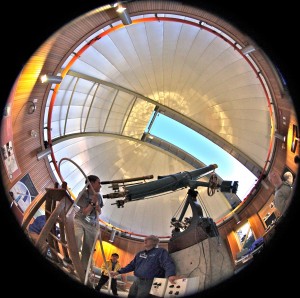By Roberta Attanasio, Forever Leaders Editor
According to the White House Office of Science and Technology Policy, STEM (science, technology, engineering and mathematics) fields “are essential to America’s economic growth and global competitiveness; however, there is currently a mismatch between the supply and growing demand for STEM-skilled workers.” Women represent a largely untapped pool, as gender disparities continue to be present in all STEM fields. Statistics from the National Science Foundation show that, since the late 1990s, more women than men enroll in college; women have earned 57% of all bachelor’s degrees and about half of STEM bachelor’s degrees. However, women’s representation is still low at higher position levels. For example, women’s share of full-time, full professorships has more than doubled since 1993. Despite this increase, women currently occupy only about one-fourth of these senior faculty positions.

Photo Credit: Steve Jurvetson, CC BY 2.0.
In addition, women’s level of participation in STEM fields varies—it is highest in psychology, where women account for 70% or more of the graduates at each degree level. Women’s participation is also relatively high in biosciences and social sciences (except for economics). The proportion of women is lowest in engineering, computer sciences, and physics. Not surprisingly, then, a new study (published on October 10, 2016, in the scientific journal Psychological Bulletin) focuses on the following question: Why are women represented in some STEM fields more than others?
To answer this question, researchers carried out a critical review of the most commonly cited factors explaining gender disparities in STEM participation, and investigated whether these factors explain differential gender participation across STEM fields. For the study (Why Are Some STEM Fields More Gender Balanced Than Others?), researcher first analyzed more than 1,200 papers about women’s underrepresentation in STEM. On the basis of this analysis, they identified ten factors that impact gender differences in students’ interest and participation in STEM. From these, the researchers selected the three factors most likely to explain the lower representation of women in engineering, computer science, and physics, when compared to other stem fields. The three factors are a lack of pre-college experience (lack of sufficient early experience with engineering, computer science, and physics), gender gaps in belief about one’s abilities (gender gaps in self-efficacy), and a masculine culture that discourages women from participating (masculine culture that signals a lower sense of belonging to women than men).
The researchers found that this masculine culture includes three main aspects: stereotypes of the fields that are incompatible with how women perceive themselves, negative stereotypes about women’s abilities, and a dearth of role models. Together, these factors appear to decrease women’s interest in a specific field by signaling that they do not belong there.
Sapna Cheryan, lead author of the study, said in a press release: “There is widespread knowledge that women are underrepresented in STEM, but people tend to lump STEM fields together. This is one of the first attempts to really dig down into why women are more underrepresented in some STEM fields than others.”
The researchers conclude that a more inclusive culture across STEM fields is the most effective way to increase women’s participation in computer science, engineering, and physics. Moreover, women’s participation may increase by providing students with early experiences that signal equally to both girls and boys that they belong and can succeed in these fields.
Copyright © 2016-2018 Forever Leaders.




When the disparities were pointed out to me, I had an “Aha!” moment. I am struggling in physics, not because I don’t believe in myself, but because this happens to be a subject I am struggling with at the moment. The professor is not the best when it comes to teaching it. She is extremely smart and doesn’t know how to translate the subject for us. I really fear that this course may be my first C- ever. I, however, have never blamed the professor’s gender on any of this. However, there is an aura in the room where her gender is concerned. A lot of the male students will throw her off track in attempts to correct her or they will make it seem like she doesn’t know what she is talking about. In reality, she’s so smart she makes the subject harder. I can often hear it in her voice that they are getting to her. And it amazes me that a woman as smart as she is can doubt herself in such a way. But this scenario speaks to a lot of situations in the science community– it’s a male dominated field where the males subconsciously (or consciously) attempt to prove that they are the one’s who are dominant.
I have had similar experiences in the classroom. My current physics professor is also a woman, and it seems like people are less respectful to her than the male teaching assistant. English is not her first language, so she already comes across a bit timid (which is completely understandable if your vocabulary isn’t as expansive as your students). What really got to me was the fact that many students, including women, felt they could talk over her, snicker at her mispronunciation of words, and consistently complain about the subject. It was primarily male students who would be bold enough to interrupt her and point out a spelling mistake or something trivial like that. In high school I was known to call people (primarily boys) out when they were being rude to a teacher. The times I intervened were almost always on behalf of a female teacher, which makes me very sad. There are so many smart, even brilliant, women who question their intelligence based on the commentary of less-educated members of society (cough-cough, high school students). I do not think the classroom is a place where women must exercise their defensive skills, but there is a need for it right now. It seems that society has made it necessary to learn how to defend ourselves and one another from inappropriate onslaught in the classroom.
After reading this post, I realize how large the misrepresentation of women in physics, computer science, and engineering is. I understand now how ignorant I have been. I like many others have bunched all categories of STEM together, making me not see that women are still underrepresented in the physics, computer science, and engineering fields. I believe this has to do with the gender norms and stereotypes our society has. According to Sherry Ortner, women are seen closer to nature while men are seen the closer culture. The simplified reason for this that women give birth (nature) and men create (culture). While this is a simplified explanation of Ortner’s theory of women being seen as second class citizens and how the domestic sphere shapes gender roles. This theory could be used to explain gender stereotypes are seen in physics, computer science, and engineering. These three fields are seen as fields that create things and advances are constantly made in making the fields seen as a masculine job, Everyone without knowing it follows gender norms and without knowing it women are not entering these fields. The underrepresentation of women in these fields leads to women are being discouraged from entering. More women need to enter these fields and encourage the next generation. The answer may seem simple however it is hard for women to enter when in a class of 40 there are only three women in the whole class. This will take time to change, but we as women should encourage more women to enter in order to start changing the representation of women in these fields.
I really enjoyed reading the Ortner’s theory. I agree that it is time to encourage more women to enter into the STEM field. However, I believe that encouragement only goes so far. Young kids, middle school students, high school student, etc share a common downfall and that is they lack the a good foundation in the math and science field. A lot of kids struggle with understanding the basic concepts of mathematics, and struggle even more when they are forced to apply mathematical concepts to science. Thus, I believe that efforts need to start with providing resources for those children to excel. We need to provide more tutors, books, homework hotlines, and more one on one time. Children need support from both of their parents, which means men need to be more involved at home. Solving the educational resource gap could enhance interests in science and math and encourage more women to be involved in the STEM field.
Gender stereotypes and biases affect every living human in the world. They control the way we behave, the way we perceive others, the way we interact with one another, and just the way we view the world as a whole. Women under representation in STEM field related careers is simply a result of gender stereotypes. The facts and numbers don’t lie. It is not that women are not as educated or driven as men to be able to excel in performance on a STEM field related career – it is the fact that they do not feel it is their “place” in society to excel.
Science, technology, engineering, and mathematics – these are all academic disciplines that are intellectually-based, driven by facts not emotion, and are mentally challenging. These are all characteristics that, based on societal standards, belong solely to men. Men should be facts-driven, rational, intellectual, and determined. Women, on the other hand, “should” be emotions-driven, compassionate, intuitive, etc. This might help to explain why women’s level of participation in STEM fields is highest in psychology, and NOT say, engineering. Gender stereotypes rule the world – they influence the decisions we make in this life whether we know it or not. It is due to these biases that the facts have turned out the way they have. In order to combat women’s under representation in STEM field related careers, we have to revolutionize the way we view each other – by deciding to not categorizing humans based on physical characteristics.
After reading this post, I reflected on my prospective career choices. Even though I was always exceptional in math and fascinated with engineering, I never considered it as an option. Why? Why did I perceive that career as being out of character? I realized that there was not one woman in my social circle that involved themselves in a STEM field. It is almost like it was an understood phenomenon between both genders that those fields were more suited for men. No one questioned it either. If I had one person in my life that either showed or told me that I am just as capable as a man to do these things, maybe I would have made different choices. I am glad that I am involved in a science (Psychology). But I will always wonder if I could have demonstrated by true talents as an engineer. If I never get the chance to find out, I am going to make sure that future generations of girls and women understand that there are no limitations or boundaries. I will make sure they know every option is available to them.
I’m a Computer Science major and I am lucky if I see three others girls in any of my classes where the average size ranges from 45-60 students. Like you I was always good at math and my dad also majored in Computer Science when he was in college which is part of the reason I chose it. The first intro class I took was hard and the male students were not very willing to help. I wanted to change my major but my dad encouraged me to stick it out until the end of the semester and I’m glad I did. I agree with this post in that many women chose not to study computer science, engineering, or physics because they are associated as male jobs. I think as women in science it is our job to expose the next generation of women to all aspects of STEM and if they chose to pursue a career in science we need to encourage them to finish. Many of the girls who I made friends with in my intro computer science class changed their majors before the midterm. I would have done the same if it wasn’t for the support of my father. We need more women in these fields so that we can change the way the next generation views these careers. If they see more women in computer science and physics based jobs they may be more inclined to follow that path and in turn will have more support from people encouraging them to finish.
This topic is one I feel to be very important for women in science today. Using the term STEM tends to point to this all-inclusive area of science and it’s true that the representation of women varies between them all. In my opinion, biology, chemistry, and psychology seem to always be the focus when it comes to talking about women in science. It is as if we’ve deemed these areas to be women capable and the others to be strictly male. We are stereotyping these areas of science without concern for the representation of women being equal amoung all.
I do believe we need to begin introductions to the areas of physics, computer science, and engineering at the lower levels of education, like middle school and high school. Schools focus heavily on biology and chemistry, but never on the science of technology. With the way the world is moving, it will benefit all individuals to have knowledge in these areas. How else do we increase representation of women in these areas, if they never get the opportunity to discover a passion for it?
I have struggled with this particular topic. I was always interested in engineering and computer science, but decided not to pursue it in college, instead choosing a more biology route in neuroscience. My reasoning was because of the one physics class I took that became my hardest class taken, and that if this one encounter was so bad for me, engineering and computer science would not go so well either. If I had had the opportunity to explore these areas, giving them a chance before reaching college, I may have found a rhythm and a passion, but that opportunity was not available to me.
We need to bring all of STEM to middle and highs school and encourage women to venture into these areas and discover their passions. These areas are missing out on so many women who just never got the chance to explore engineering, computer science, and physics in more creative and broadening ways.